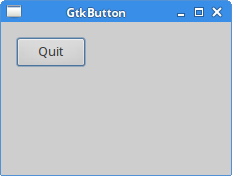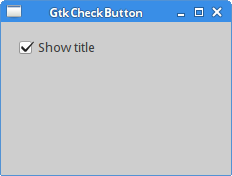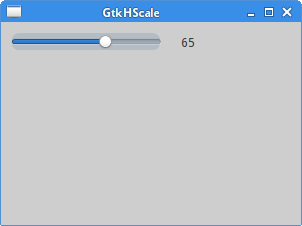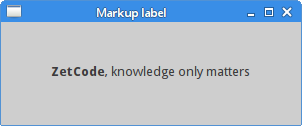GTK+ Widgets
last modified October 18, 2023
In this part of the GTK+ programming tutorial, we introduce some GTK+ widgets.
Widgets are basic building blocks of a GUI application. Over the years, several widgets became a standard in programming toolkits; for example a button, a check box, or a scroll bar. The GTK+ toolkit's philosophy is to keep the number of widgets at a minimum level. More specialised widgets are created as custom GTK+ widgets.
GtkButton
GtkButton is a simple widget that is used to trigger an action.
#include <gtk/gtk.h>
int main(int argc, char *argv[]) {
GtkWidget *window;
GtkWidget *halign;
GtkWidget *btn;
gtk_init(&argc, &argv);
window = gtk_window_new(GTK_WINDOW_TOPLEVEL);
gtk_window_set_title(GTK_WINDOW(window), "GtkButton");
gtk_window_set_default_size(GTK_WINDOW(window), 230, 150);
gtk_container_set_border_width(GTK_CONTAINER(window), 15);
gtk_window_set_position(GTK_WINDOW(window), GTK_WIN_POS_CENTER);
halign = gtk_alignment_new(0, 0, 0, 0);
gtk_container_add(GTK_CONTAINER(window), halign);
btn = gtk_button_new_with_label("Quit");
gtk_widget_set_size_request(btn, 70, 30);
gtk_container_add(GTK_CONTAINER(halign), btn);
g_signal_connect(G_OBJECT(btn), "clicked",
G_CALLBACK(gtk_main_quit), G_OBJECT(window));
g_signal_connect(G_OBJECT(window), "destroy",
G_CALLBACK(gtk_main_quit), NULL);
gtk_widget_show_all(window);
gtk_main();
return 0;
}
The example shows a button that is positioned in the upper-left corner of the window. The application quits when we click on the button.
btn = gtk_button_new_with_label("Quit");
The gtk_button_new_with_label creates a new GtkButton with a label.
g_signal_connect(G_OBJECT(btn), "clicked",
G_CALLBACK(gtk_main_quit), G_OBJECT(window));
The button's clicked signal is connected to the
gtk_main_quit function, which terminates the application.

GtkCheckButton
GtkCheckButton is a widget that has two states: on and off.
The on state is visualized by a check mark.
#include <gtk/gtk.h>
void toggle_title(GtkWidget *widget, gpointer window) {
if (gtk_toggle_button_get_active(GTK_TOGGLE_BUTTON(widget))) {
gtk_window_set_title(window, "GtkCheckButton");
} else {
gtk_window_set_title(window, "");
}
}
int main(int argc, char** argv) {
GtkWidget *window;
GtkWidget *halign;
GtkWidget *cb;
gtk_init(&argc, &argv);
window = gtk_window_new(GTK_WINDOW_TOPLEVEL);
gtk_window_set_position(GTK_WINDOW(window), GTK_WIN_POS_CENTER);
gtk_container_set_border_width(GTK_CONTAINER(window), 15);
gtk_window_set_default_size(GTK_WINDOW(window), 230, 150);
gtk_window_set_title(GTK_WINDOW(window), "GtkCheckButton");
halign = gtk_alignment_new(0, 0, 0, 0);
gtk_container_add(GTK_CONTAINER(window), halign);
cb = gtk_check_button_new_with_label("Show title");
gtk_toggle_button_set_active(GTK_TOGGLE_BUTTON(cb), TRUE);
GTK_WIDGET_UNSET_FLAGS(cb, GTK_CAN_FOCUS);
gtk_container_add(GTK_CONTAINER(halign), cb);
g_signal_connect(window, "destroy",
G_CALLBACK(gtk_main_quit), NULL);
g_signal_connect(cb, "clicked",
G_CALLBACK(toggle_title), (gpointer) window);
gtk_widget_show_all(window);
gtk_main();
return 0;
}
The example displays a window title depending on the state of the GtkCheckButton.
cb = gtk_check_button_new_with_label("Show title");
gtk_toggle_button_set_active(GTK_TOGGLE_BUTTON(cb), TRUE);
The GtkCheckButton is created and is marked by default;
the title is initially shown.
GTK_WIDGET_UNSET_FLAGS(cb, GTK_CAN_FOCUS);
This code line disables the focus.
if (gtk_toggle_button_get_active(GTK_TOGGLE_BUTTON(widget))) {
gtk_window_set_title(window, "GtkCheckButton");
} else {
gtk_window_set_title(window, "");
}
We show the title of the window, depending on the state of the
GtkCheckButton. To set a title of the window, we use
the gtk_window_set_title.

GtkFrame
GtkFrame is a bin with a decorative frame and optional label.
#include <gtk/gtk.h>
int main(int argc, char *argv[]) {
GtkWidget *window;
GtkWidget *table;
GtkWidget *frame1;
GtkWidget *frame2;
GtkWidget *frame3;
GtkWidget *frame4;
gtk_init(&argc, &argv);
window = gtk_window_new(GTK_WINDOW_TOPLEVEL);
gtk_window_set_position(GTK_WINDOW(window), GTK_WIN_POS_CENTER);
gtk_window_set_default_size(GTK_WINDOW(window), 250, 250);
gtk_window_set_title(GTK_WINDOW(window), "GtkFrame");
gtk_container_set_border_width(GTK_CONTAINER(window), 10);
table = gtk_table_new(2, 2, TRUE);
gtk_table_set_row_spacings(GTK_TABLE(table), 10);
gtk_table_set_col_spacings(GTK_TABLE(table), 10);
gtk_container_add(GTK_CONTAINER(window), table);
frame1 = gtk_frame_new("Shadow In");
gtk_frame_set_shadow_type(GTK_FRAME(frame1), GTK_SHADOW_IN);
frame2 = gtk_frame_new("Shadow Out");
gtk_frame_set_shadow_type(GTK_FRAME(frame2), GTK_SHADOW_OUT);
frame3 = gtk_frame_new("Shadow Etched In");
gtk_frame_set_shadow_type(GTK_FRAME(frame3), GTK_SHADOW_ETCHED_IN);
frame4 = gtk_frame_new("Shadow Etched Out");
gtk_frame_set_shadow_type(GTK_FRAME(frame4), GTK_SHADOW_ETCHED_OUT);
gtk_table_attach_defaults(GTK_TABLE(table), frame1, 0, 1, 0, 1);
gtk_table_attach_defaults(GTK_TABLE(table), frame2, 0, 1, 1, 2);
gtk_table_attach_defaults(GTK_TABLE(table), frame3, 1, 2, 0, 1);
gtk_table_attach_defaults(GTK_TABLE(table), frame4, 1, 2, 1, 2);
g_signal_connect(G_OBJECT(window), "destroy",
G_CALLBACK(gtk_main_quit), G_OBJECT(window));
gtk_widget_show_all(window);
gtk_main();
return 0;
}
The example shows four different frame types. The frames are attached into a table container.
frame1 = gtk_frame_new("Shadow In");
The gtk_frame_new function creates a GtkFrame
with an optional label.
gtk_frame_set_shadow_type(GTK_FRAME(frame1), GTK_SHADOW_IN);
The gtk_frame_set_shadow_type function sets a shadow type
for a frame.

GtkHScale
GtkHScale is a horizontal slider widget for selecting a value
from a range of values.
#include <gtk/gtk.h>
void value_changed(GtkRange *range, gpointer win) {
gdouble val = gtk_range_get_value(range);
gchar *str = g_strdup_printf("%.f", val);
gtk_label_set_text(GTK_LABEL(win), str);
g_free(str);
}
int main(int argc, char *argv[]) {
GtkWidget *window;
GtkWidget *halign;
GtkWidget *hbox;
GtkWidget *hscale;
GtkWidget *label;
gtk_init(&argc, &argv);
window = gtk_window_new(GTK_WINDOW_TOPLEVEL);
gtk_window_set_position(GTK_WINDOW(window), GTK_WIN_POS_CENTER);
gtk_window_set_default_size(GTK_WINDOW(window), 300, 250);
gtk_container_set_border_width(GTK_CONTAINER(window), 10);
gtk_window_set_title(GTK_WINDOW(window), "GtkHScale");
hbox = gtk_hbox_new(FALSE, 20);
hscale = gtk_hscale_new_with_range(0, 100, 1);
gtk_scale_set_draw_value(GTK_SCALE(hscale), FALSE);
gtk_widget_set_size_request(hscale, 150, -1);
label = gtk_label_new("...");
gtk_misc_set_alignment(GTK_MISC(label), 0.0, 1);
gtk_box_pack_start(GTK_BOX(hbox), hscale, FALSE, FALSE, 0);
gtk_box_pack_start(GTK_BOX(hbox), label, FALSE, FALSE, 0);
halign = gtk_alignment_new(0, 0, 0, 0);
gtk_container_add(GTK_CONTAINER(halign), hbox);
gtk_container_add(GTK_CONTAINER(window), halign);
g_signal_connect(window, "destroy",
G_CALLBACK(gtk_main_quit), NULL);
g_signal_connect(hscale, "value-changed",
G_CALLBACK(value_changed), label);
gtk_widget_show_all(window);
gtk_main();
return 0;
}
In the example, we have a horizontal scale widget and a label widget. The currently chosen value is displayed in the label.
gdouble val = gtk_range_get_value(range);
The gtk_range_get_value function retrieves the
currently selected value from the scale widget.
gchar *str = g_strdup_printf("%.f", val);
gtk_label_set_text(GTK_LABEL(win), str);
We build a string value with the g_strdup_printf function and
set it to the label with the gtk_label_set_text function.
hscale = gtk_hscale_new_with_range(0, 100, 1);
The gtk_hscale_new_with_range function creates a new horizontal
scale widget with the given range. The first parameter is the minimum value,
the second parameter is the maximum value, and the last parameter is the step.
gtk_scale_set_draw_value(GTK_SCALE(hscale), FALSE);
The gtk_scale_set_draw_value specifies whether the current value
is displayed as a string next to the slider. We turn the value off. Instead, we
programmatically set it to the label widget.

GtkLabel
The GtkLabel widget displays text.
#include <gtk/gtk.h>
int main(int argc, char *argv[]) {
GtkWidget *window;
GtkWidget *label;
gtk_init(&argc, &argv);
window = gtk_window_new(GTK_WINDOW_TOPLEVEL);
gtk_window_set_position(GTK_WINDOW(window), GTK_WIN_POS_CENTER);
gtk_window_set_title(GTK_WINDOW(window), "No sleep");
gtk_container_set_border_width(GTK_CONTAINER(window), 15);
label = gtk_label_new("I've always been too lame\n\
To see what's before me\n\
And I know nothing sweeter than\n\
Champaign from last New Years\n\
Sweet music in my ears\n\
And a night full of no fears\n\
\n\
But if I had one wish fulfilled tonight\n\
I'd ask for the sun to never rise\n\
If God passed a mic to me to speak\n\
I'd say \"Stay in bed, world,\n\
Sleep in peace");
gtk_label_set_justify(GTK_LABEL(label), GTK_JUSTIFY_CENTER);
gtk_container_add(GTK_CONTAINER(window), label);
g_signal_connect(window, "destroy",
G_CALLBACK(gtk_main_quit), NULL);
gtk_widget_show_all(window);
gtk_main();
return 0;
}
The example shows two verses of a song.
label = gtk_label_new("I've always been too lame\n\
To see what's before me\n\
...
We create a GtkLabel widget. We can create
multiline text label by using a new line character. Note the escape
character. We use a rather long string and we do not want to put all the text into
one line. In such cases, we can use an escape character.
gtk_label_set_justify(GTK_LABEL(label), GTK_JUSTIFY_CENTER);
The gtk_label_set_justify function aligns the text in
the label. With the GTK_JUSTIFY_CENTER type, the text
is centered.

Label with markup
GtkLabel can also display markup language. The markup is the
Pango text markup language.
#include <gtk/gtk.h>
int main(int argc, char *argv[]) {
GtkWidget *window;
GtkWidget *label;
gtk_init(&argc, &argv);
window = gtk_window_new(GTK_WINDOW_TOPLEVEL);
gtk_window_set_position(GTK_WINDOW(window), GTK_WIN_POS_CENTER);
gtk_window_set_default_size(GTK_WINDOW(window), 300, 100);
gtk_window_set_title(GTK_WINDOW(window), "Markup label");
gchar *str = "<b>ZetCode</b>, knowledge only matters";
label = gtk_label_new(NULL);
gtk_label_set_markup(GTK_LABEL(label), str);
gtk_container_add(GTK_CONTAINER(window), label);
gtk_widget_show(label);
g_signal_connect(window, "destroy",
G_CALLBACK(gtk_main_quit), NULL);
gtk_widget_show(window);
gtk_main();
return 0;
}
The example shows a portion of text in bold.
gchar *str = "<b>ZetCode</b>, knowledge only matters";
This is the string that is displayed. It contains a simple markup.
label = gtk_label_new(NULL);
We create an empty label.
gtk_label_set_markup(GTK_LABEL(label), str);
The gtk_label_set_markup parses the string which is
marked up and applies its attributes to the label.

In this part of the GTK+ tutorial, we have covered GTK+ widgets.